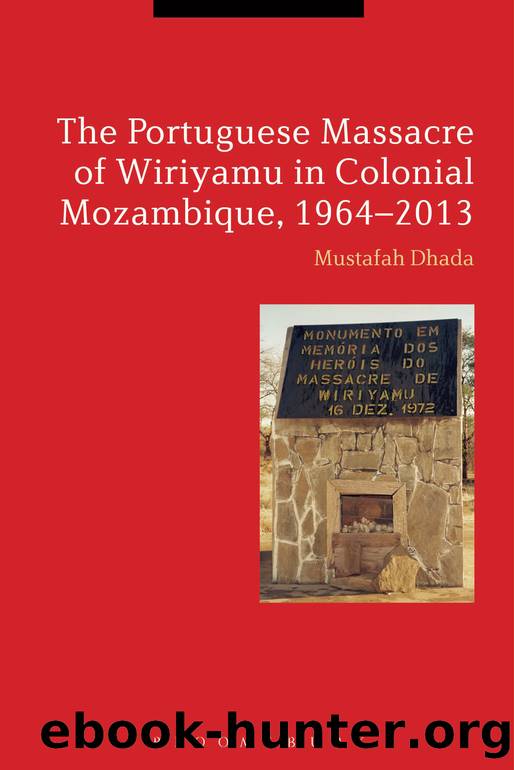The Portuguese Massacre of Wiriyamu in Colonial Mozambique, 1964-2013 by Dhada Mustafah

Author:Dhada, Mustafah [Dhada, Mustafah]
Language: eng
Format: epub
ISBN: 9781472512000
Publisher: Bloomsbury UK
Published: 2015-09-24T00:00:00+00:00
Portuguese reprisals
A month after the officerâs departure, Mucumbura saw its third bout of reprisals. FRELIMO guerrillas had crossed the border to kidnap Chief Bauren, a Rhodesian informant who had consistently betrayed FRELIMO positions with information garnered through his extensive social networks on both sides of the frontier. They failed to nab him. Alerted by his informants, Bauren had escaped, leaving his possessions behind, from which FRELIMO guerrillas took an item of value as their calling card. In the eyes of FRELIMO, he was a marked man and his Rhodesian protectors knew what to do next. They launched two operations, one to look for an âinformantâ who had betrayed Baurenâs role in Rhodesian counter-insurgent intelligence, who was subsequently found, killed, his feet and hands cut off. He had been left on a hillock near Deveteve as a deterrent to others from his village.
The Christian community in the village rallied to give him a proper burial with the Burgos priests in attendance, who then found the perpetrators after a brief search. Confronting them with the facts, the priests stressed that the deceased, named David, was an upstanding member of the local community, married with four children, and came from a long family of community-minded civic leaders, and decidedly not a FRELIMO member or politically connected with Rhodesian insurgents.65 âA very unfortunate thing, Father. Sorry, we thought he was a terrorist.â66
Five days later, another unit of Rhodesian troops, having committed a similar error of judgment in Singe, attempted a cover-up by burning the bodies of eight civilian victims.67 Villagers found the charred remains the next day and informed Valverde de Lion and Hernandez Robles. This time, they took a camera to the site guided by two children who had dodged bullets during the crossfire. They found the remains which they photographed and sent to the bishop of Tete. Would the bishop now do something about this? An officer arrived two days later at the mission demanding the Burgos hand over any additional photographs in their possession. âWe informed him that we had already given everything we had to the bishop in Tete,â who unbeknown to them had already sent the film to Lourenço Marques to be developed. Teteâs bishop, who was duly informed of the meeting with the military, now feared he would not get back the offending images, which the Burgos had hoped could be used as admissible evidence to initiate legal proceedings over mass violence in Mucumbura.68
Now that the evidence was presumed to be in the hands of the secret police, it was fair to assume that the two priests were persons of great interest to the authorities.69 It was only a matter of time before they, too, were hauled in for interrogation. Almost immediately after this incident, thirty-one Tete missionaries met to draft a note urging Teteâs bishop to speak up against mass violence; it was signed by thirty-six named priests and delivered on July 1, 1972.
In the meantime, the Burgos of Mucumbura watched helplessly as their mission unraveled before their eyes.
Download
This site does not store any files on its server. We only index and link to content provided by other sites. Please contact the content providers to delete copyright contents if any and email us, we'll remove relevant links or contents immediately.
| Africa | Americas |
| Arctic & Antarctica | Asia |
| Australia & Oceania | Europe |
| Middle East | Russia |
| United States | World |
| Ancient Civilizations | Military |
| Historical Study & Educational Resources |
Machine Learning at Scale with H2O by Gregory Keys | David Whiting(4185)
Never by Ken Follett(3794)
Fairy Tale by Stephen King(3220)
The Man Who Died Twice by Richard Osman(2997)
Oathbringer (The Stormlight Archive, Book 3) by Brandon Sanderson(2888)
Will by Will Smith(2794)
Rationality by Steven Pinker(2291)
The Dark Hours by Michael Connelly(2245)
Can't Hurt Me: Master Your Mind and Defy the Odds - Clean Edition by David Goggins(2228)
The Dawn of Everything: A New History of Humanity by David Graeber & David Wengrow(2122)
Friends, Lovers, and the Big Terrible Thing by Matthew Perry(2119)
Principles for Dealing With the Changing World Order: Why Nations Succeed and Fail by Ray Dalio(1974)
HBR's 10 Must Reads 2022 by Harvard Business Review(1777)
A Short History of War by Jeremy Black(1762)
Go Tell the Bees That I Am Gone by Diana Gabaldon(1687)
515945210 by Unknown(1599)
A Game of Thrones (The Illustrated Edition) by George R. R. Martin(1590)
Kingdom of Ash by Maas Sarah J(1527)
443319537 by Unknown(1470)
